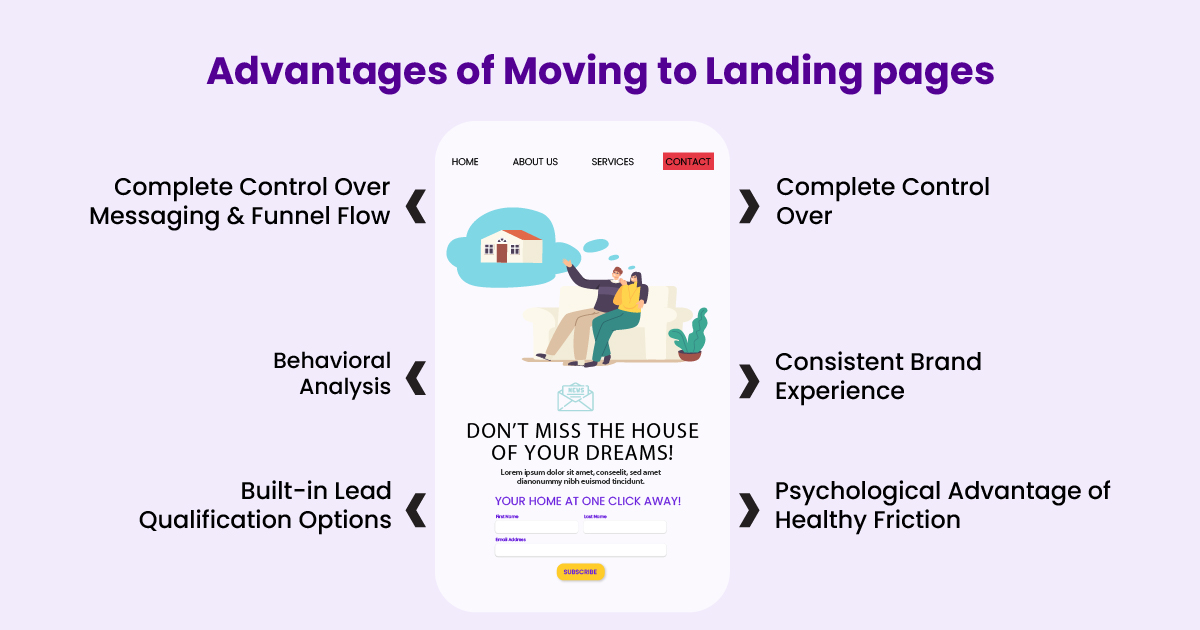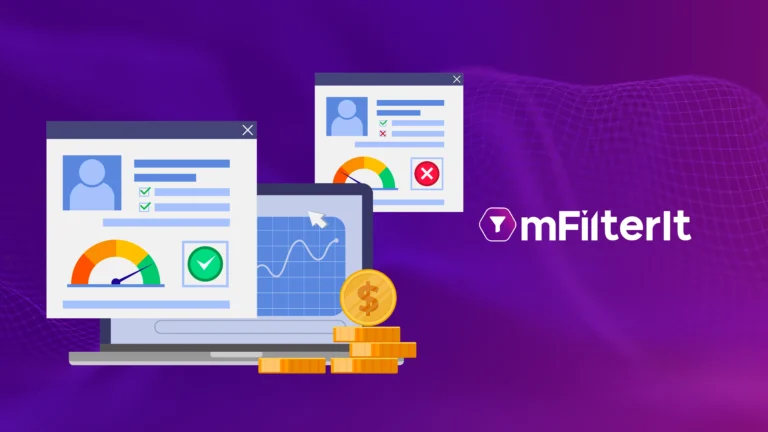You have done everything by the book.
Made a fully optimized, well-researched campaign, targeted a precise audience, and got engaging creatives made by your team. Even your dashboards show that the campaigns are performing great.
But what you hear from your sales team is a whole different story.
“Fake leads, wrong phone numbers, uninterested people, never heard of the brand before”
Leaving your performance credibility being questioned.
It’s not that your strategy is flawed. You’ve done exactly what a high-performing Meta lead gen campaign demands, what every marketer does.
The problem lies in where those leads are being captured from.
Meta’s native lead forms are built for speed and simplicity, which makes them great for collecting high volumes of leads. However, since Meta is a walled garden, a closed ecosystem,
This gap in visibility is what allows fake sign-ups, bots, and low-intent leads to slip through. And by the time sales flag the problem, it’s too late, the budgets are spent, the data is messy, and the targets are affected.
The way forward isn’t to stop running Meta campaigns; it’s to change the lead-capturing strategy. By shifting traffic to dedicated landing pages, you bring leads into an environment you control, where real-time validation and ad fraud solutions can help you ensure that only genuine, sales-ready leads make it through. This means cleaner CRMs, stronger conversion rates, and a lot fewer tense conversations in post-campaign reviews.
Continue reading further to know how it works.
Understanding The Problem: Why Meta Lead Gen Campaigns Produce Junk Leads?
Meta’s native lead forms are optimized for speed, efficiency, and ease for a seamless user experience. Users can easily fill in the form with a couple of taps, often using pre-filled information extracted from their profiles. While this effortless experience boosts form submissions, it also makes the campaigns vulnerable to lead generation fraud.
This ease in the process makes it even more easier for the bots, or click farms (low-paid workers), to fill in the forms.
Moreover, the bots easily bypass the basic level checks like CAPTCHAs and OTPs using CAPTCHA solvers available at just one click. That is why, marketers relying solely on these efforts to prevent junk leads lack behind.

Here’s how junk leads fill in, when left unchecked:
- Invalid or fake phone numbers and emails – Many users submit temporary, outdated, or fabricated contact details. Some don’t even review the pre-filled information before hitting submit, leaving you with leads that cannot be contacted or verified.
- Bots and click farms – Automated scripts and low-paid workers mass-fill thousands of forms within a matter of few minutes. While they make your numbers look impressive on the dashboards, they have zero intent to buy and generate zero actual revenue.
- Zero-intent leads – These are people who sign up purely out of curiosity to know what’s next, boredom, or by mistake. Since there’s little to no effort involved, they have no genuine interest and rarely convert into paying customers.
- Repeated or duplicate submissions – The same user, or an automated system, submits identical details multiple times. This inflates your lead count, clogs your CRM with fake leads, and wastes valuable time of sales team resources on the same invalid contacts.
The combination of these factors completely disrupts the campaign goals, skewing performance metrics, and manipulating further campaign optimizations or remarketing efforts.
So, if you have ever wondered why your Meta lead generation campaigns have great CPL but disappointing conversions, above mentioned are likely the reason, the system is rewarding volume, not quality.
The Impact of Junk Leads on Business Growth
The impact of junk leads is far-reaching. These fake leads don’t just waste money; they sabotage your entire marketing system. Here how:
- Direct financial loss: You’re paying for every click, impression, and form submission. If 40–50% of those are fake or irrelevant, that’s a significant chunk of your ad spend going to waste.
- Wastage of operational efforts: Your sales team spends valuable hours chasing invalid numbers, disconnected lines, and people who have no interest in your offer. This not only wastes time but also lowers morale.
- Misleading campaign data: Junk leads distort your web performance metrics, making your campaigns look better than they actually are. Your reported conversion rates may seem healthy, but the actual sales numbers tell a different story.
- Poor remarketing audiences: When your CRM is full of low-quality leads, your lookalike and retargeting campaigns also suffer. You’re essentially teaching Meta algorithm to target more of the wrong people.
- Damaged brand reputation: Repeatedly contacting people who never wanted to hear from you in the first place can hurt your brand image and even lead to spam complaints.
Therefore, to combat junk lead generation fraud, advertisers are now transitioning from native Meta lead forms to dedicated landing pages with custom leads forms.
Why Marketers Should Move from Native Ad Forms to Landing Pages?
The shift from native Meta lead forms to redirecting the traffic to dedicated landing pages gives marketers more control, cleaner data, and better lead quality. Here’s how:

1. Complete control over messaging and funnel flow
A landing page lets you customize headlines, copy, images, and CTAs to match your campaign objectives. You can guide visitors through a carefully structured journey that builds interest before asking them to fill out a lead form. This helps pre-qualify the lead before it even hits the form.
2. Higher accuracy in data
Unlike native forms that pull pre-filled details from a user’s Meta profile (often outdated), landing pages require users to manually enter their information. This reduces the risk of invalid or old phone numbers, emails, and incorrect names entering into your CRM.
3. Behavioral analysis
On a landing page, advertisers can measure valuable engagement signals like scroll depth, time spent on the page, clicks on key elements, etc. These metrics help you understand how invested a visitor was and also help identify patterns for high-quality leads.
4. Consistent brand experience
Campaigns having default Meta lead forms are bound to have the same preset design and layout. On the other hand, landing pages give marketers complete creative freedom to design lead forms, aligning with brand’s tone, style, and visual identity, making the experience seamless for the audience.
5. Gain full transparency with third-part lead validation
Landing pages allow you to integrate third-party lead validation tools, giving marketers real-time visibility into the quality of every submission. From detecting bots and duplicate entries to verifying contact details and intent, this added layer of protection ensures only genuine leads enter your funnel, reducing junk leads and boosting campaign trust.
However, it is also important for marketers to note that simply redirecting traffic to a landing page isn’t enough. Though they act as a first quality checkpoint in your funnel, they do not completely ensure 100% validated lead quality. That’s where ad traffic validation solutions are needed.
How an Ad Fraud Solution Prevents Fake Leads from Entering the Funnel?
Taking control of your campaigns’ lead quality and preventing fake leads from entering the funnel requires a structured, technology-driven approach that can validate each lead based on various parameters proactively. An advanced ad fraud solution acts as a gatekeeper, filtering out invalid, duplicate, and bot-driven leads before they ever reach your CRM. Here’s how it works:
Real-Time Traffic Filtering and Fraud Prevention
An ad fraud solution starts by analyzing every visit coming to your landing page. Using advanced detection methods, it flags and blocks invalid traffic from sources like bots, VPNs, proxies, device spoofing, and repeated IP addresses. By filtering out this traffic before form submission, it prevents fake leads at the earliest stage, ensuring your campaign is further built on cleaner and reliable data.
Intent-Based Behavioral Analysis
Not all visitors are equal; some are genuine prospects, while others are accidental clicks or low-intent browsers. Fraud detection technology measures key behavioral signals like time on page, scroll depth, click patterns, and navigation flow. This intent analysis separates window shoppers from truly interested prospects, helping you prioritize leads with the highest potential to convert.
Lead Scoring and Validation
Once a lead submits a form, a robust ad fraud solution assigns a quality score using AI and machine learning models. These models assess multiple data points from demographic accuracy to engagement history and network signals to determine authenticity and purchase intent. Leads with low scores are deprioritized or filtered out entirely, allowing your sales team to focus only on high-value prospects.
Device and Behavioral Tracking
Fraudulent actors often mask their identity, but device fingerprinting and IP tracking help expose them. By capturing unique device signatures, location data, and network behavior, the system identifies patterns linked to fake lead submissions, including repeated sign-ups from the same device or IP range, and flags them instantly.
Proactive Blocking and Source Blacklisting
Once fake leads are identified, the fraud detection tool takes immediate action. This includes blacklisting known fraudulent IPs, devices, or affiliates that repeatedly fail validation checks. Over time, this proactive blocking reduces the likelihood of bad actors re-entering your campaigns, ensuring your media budget is spent only on legitimate prospects.
mFilterIt’s User Intent Scoring Mechanism

- Real-time AI & ML scoring – Scores each visit and lead instantly, detecting invalid traffic from bots, proxies, device spoofing, and repeated IPs.
- CRM integration – Assigns a customizable risk score (high, moderate, low intent) so brands can prioritize or discard leads accordingly.
- Advanced fraud detection – Uses device fingerprinting, IP tracking, and behavioral analysis to spot fake form submissions.
- Data enrichment & identity verification – Cross-checks contact details against social, web, and risk databases for authenticity.
- Active source blacklisting – Blocks fraudulent IPs, devices, and affiliates to prevent repeat attacks.
- Clean CRM, higher ROI – Ensures sales teams work only with genuine prospects, improving attribution accuracy and campaign targeting.
- Better downstream performance – Boosts call pick-up rates, verified sales, and strengthens media optimization strategies through clean data.
Conclusion
Meta lead gen campaigns can still be powerful, but only when paired with the right hygiene checks. Native forms may bring volume, but a validated landing page strategy ensures that you’re capturing intent-driven, real users who are far more likely to convert. Because leads are about getting the right ones for business growth.
So, stop wasting your ad budget on junk leads. See how mFilterIt’s lead validation can boost your Meta campaign ROI – book a demo today.





